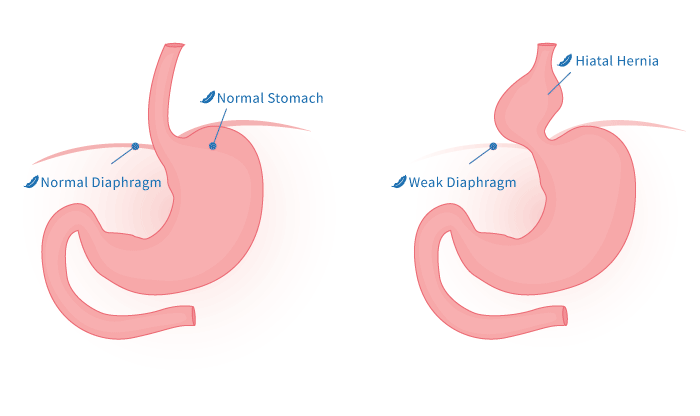WHY HIATAL HERNIA NEEDS TO BE REPAIRED?

WHAT IS A HIATAL HERNIA?
Any time an internal organ or it`s part protrudes into an area where it doesn’t belong, it’s called a hernia. A hiatal hernia is a condition when upper part of the stomach bulges up through the diaphragm and into the chest.
The diaphragm is a large muscle that lies between your abdomen and chest. This muscle helps you breathe. Normally, the esophagus (food pipe connecting your mouth to your stomach) goes through a hiatus (an opening in the diaphragm) and attaches to the stomach below the diaphragm, but people with a hiatal hernia have an upper portion of the stomach push up through the hiatus.
There are two main types of a hiatal hernia: sliding hernia (most common type), when a portion of your stomach slides through the hiatus and back, and paraoesophageal hernia, when upper portion of the stomach stays permanently squeezed through the hiatus.
WHAT CAUSES A HIATAL HERNIA?
The most common cause of a hiatal hernia is an increased pressure in the abdomen such as from coughing, vomiting, straining during a bowel movement, heavy lifting, or physical strain. Pregnancy and obesity can also lead to a hiatal hernia, and a person may be born with a larger hiatal opening.
WHO IS AT RISK?
A hiatal hernia can develop in people of all ages and both sexes, although mostly occurs in women and people who are over 50 years old. It affects up to 60 percent of people by the time they’re 60 years old, according to the Esophageal Cancer Awareness Association. Hiatal hernia occurs more often in overweight people, and smokers.
WHAT ARE THE SYMPTOMS OF A HIATAL HERNIA?
Most people with hiatal hernia do not have any symptoms, yet others have some of the same symptoms typical to gastroesophageal reflex disease (GERD). GERD occurs when digestive juices move from the stomach back into the esophagus. The esophagus sphincter muscle normally closes tightly. With a hiatal hernia, the sphincter’s new position may keep it from completely closing. The back flow of digestive juices may damage the esophagus.
Symptoms of GERD include:
- Heartburn
- Bitter or sour taste in the back of the throat
- Bloating and belching
- Discomfort or pain in the stomach or esophagus
- Chest pain or epigastric pain
There appears to be a connection between hiatal hernia and GERD, however not necessarily one condition causes the other. A lot of people have hiatal hernia and no GERD, and vice versa.
HOW IS HIATAL HERNIA DIAGNOSED?
Since most of the people with hiatal hernia do not have any symptoms, it is often diagnosed “accidentally” when a person undergoes an endoscopy for a different reason. An endoscopy and a barium swallow test are the most common ways to diagnose a hernia, others include esophageal manometric studies, a pH test, and gastric emptying studies.
Hiatal hernia is sometimes diagnosed during weight loss surgery.
SURGERY
If the hiatal hernia is being strangulated so tightly that the blood supply is being cut off in the upper part of the stomach, surgery is needed. Surgery may also be needed in people with a hiatal hernia who have severe, chronic esophageal reflux whose symptoms are not relieved by anti-acid medication. The goal of this surgery is to correct gastroesophageal reflux, which if left untreated can cause complications such as esophagitis (inflammation), esophageal ulcers, bleeding, or scarring of the esophagus.
During your weight loss surgery, if diagnosed with a hiatal hernia, Dr.Zavalza will fix it by pulling your stomach back in place and making your hiatus smaller.
HOW TO REDUCE THE RISK OF HIATAL HERNIA?
- Lose excess weight
- Do not strain during bowel movements
- Do not lift heavy objects or get help
- Avoid tight belts and certain abdominal exercises
If you have acid reflux, one of the symptoms of a hiatal hernia, follow these recommendations:
- Eat smaller meals several times a day instead of three large meals
- Avoid eating meals or snacks within a few hours of going to bed
- Avoid foods that increase the risk of heartburn: spicy foods, chocolate, foods made with tomatoes, caffeine, onions, citrus fruits, alcohol
- Stop smoking
- Avoid bending over or lying down after eating
COST OF A HIATAL HERNIA REPAIR DURING WEIGHT LOSS SURGERY
The cost of surgery for a hiatal hernia in the United States varies depending on the surgeon, your location, and the type of insurance you have. The uninsured cost of the procedure is typically about $5,000 in the United States. However, additional costs may arise during the recovery process if you have complications.
The cost of a hiatal hernia repair during weight loss surgery in Tijuana varies between $300 and $500 USD depending on the clinic.
With Dr. Zavalza and Dr. Hernandez, the fee is $300 USD (in addition to the weight loss surgery package cost).
HEALTH HISTORY QUESTIONNAIRE
To determine what type of weight loss surgery will be most beneficial for you, please complete our health history questionnaire.
Once we receive the completed form, we will contact you via email within 24 hours and arrange a free consultation with one of our bariatric surgeons via a cell phone or a video call.
